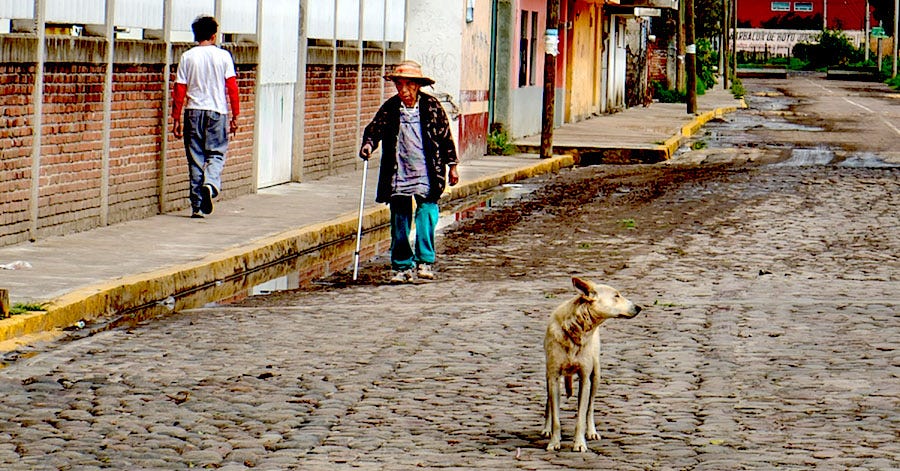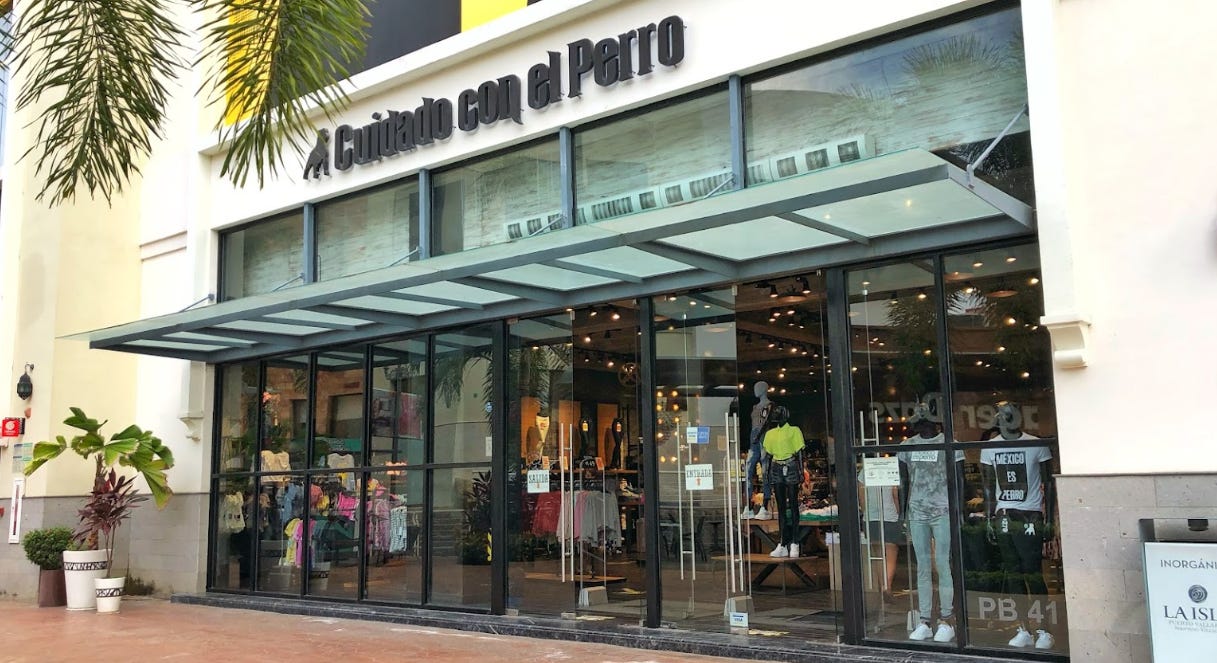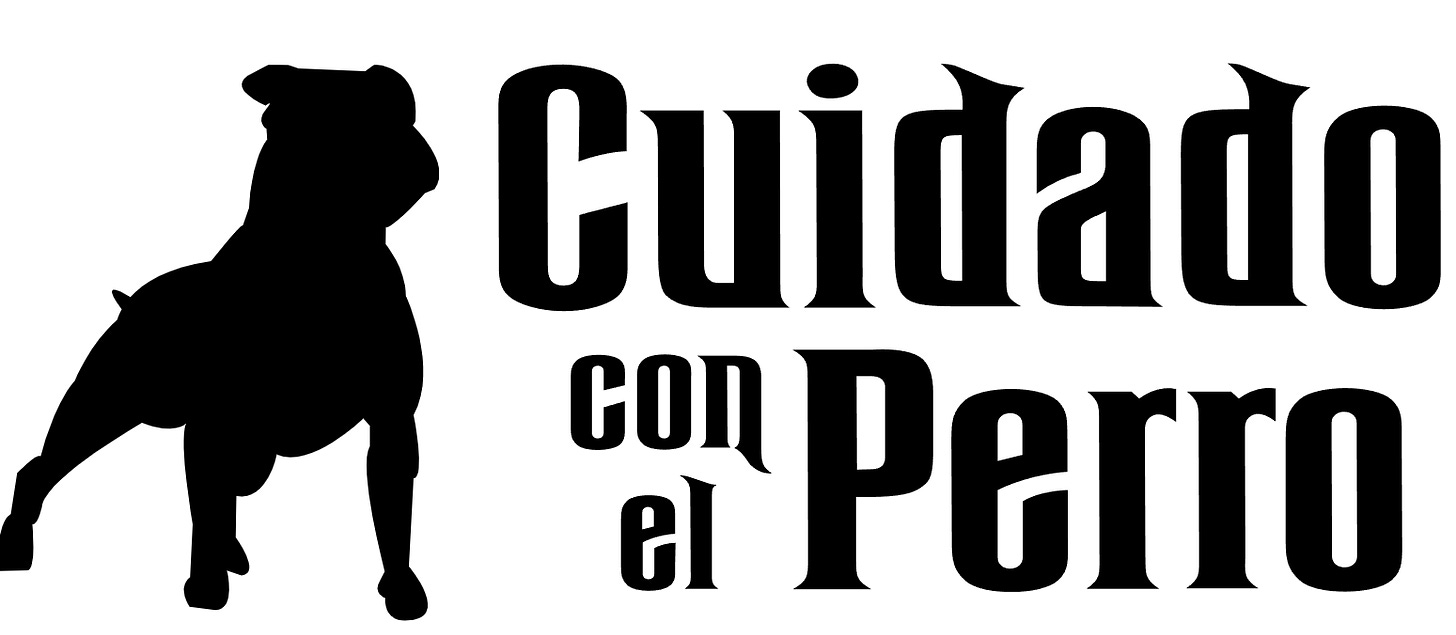Cuidado con el Perro
Cuidado con el Perro
The bark of ignorance and the bite of wisdom.
Mexican dogs don’t bark.
The heat keeps them quiet. A perpetual hunger keeps them on the hunt. They need to preserve their energy. Barking is for over-fed dogs. Lapdogs. Toy dogs. Dogs that perform as pets. Kept animals who pretend to love for frequent meals.
Mexican dogs roam endlessly in search of something edible that might have calories.
Their noses lead them up and down the cracked pavement, over the uneven curbs bloated with incompetent construction where the unrestrained earth pushes weeds between its weak points. The tourists navigate them like amateur gymnasts trying to find their balance from one comically uneven step to the next.
The Mexican dogs weave around their legs, skilled in their prowl. They follow the newest scent over the rocky streets to the next block, and the next until they arrive at the busy four-lane boulevards where sometimes they don’t even bother to stop for cars with passengers that don’t acknowledge their existence any more than a dry palm frond or discarded cola can.
A marriage of the functionally dysfunctional persists everywhere in Mexico.
The traffic system on busy roads where cars, buses, trucks, hurried taxis, pedestrians, and stray dogs all ignore each other yet find their way to their destination with only the idea of rules and regulations to guide them.
Obedience is optional because enforcement is rare.
It happens in a manner approximating successful confusion. Triumph by luck, instinct, experience, coincidence, and magic.
There are no twelve rules for life here. No collective agreements to keep the order or prevent chaos. Perhaps the only rules are the rules to ignore in the middle of the organized chaos of urban Mexican life.
Rule number one: Cuidado con el perro.
¿Que perro?
There are no crosswalks, or lights with red or green human figures to signal passage. There are no noises to cue the blind beyond the vibrating and puttering diesel engines that grow louder or quieter depending on their velocity.
A mother with two small children makes the crossing. She doesn’t hold their hand or offer them instructions. She doesn’t even look at them. They are like stray dogs following a scent. When she moves they follow. When she stops on a small grass island between the lanes of speeding traffic, the children stop next to her.
In the United States, she would be arrested for child endangerment. The paedo traffickers working for the Clinton-Soro CPS industrial complex would take them from her. If in New Zealand, the state would seize the children for tainted blood transfusions.
In Mexico, she is simply moving herself and her children from one bus stop to another on their long journey home from school and showing them how to navigate the urban obstacles as Mexicans do.
I follow the woman with my two heavy bags of groceries in each hand. The tidy obedient mind ponders questions rooted in an orderly life of following rules and laws.
Will I be detained for crossing the four-lane boulevard? Can I get fined?
The experienced Mexican traveler responds to such stupidity: “The Federales don’t have time to hand out jaywalking tickets here. They don’t bother with the little things.”
It takes a few days to learn how to navigate the bustling careterra that meanders the bay from north to south Vallarta, but when in doubt it’s best to always follow the locals.
The women’s young children are less scared than a grown gringo with groceries. They follow Mama, and I follow them, and that stray dog follows all of us, keeping her distance, using her nose which has now tracked onto my bags of food.
Buses, taxis, and trucks whizz past at 40 kilometers per hour, only a meter or less from our faces. None of them will stop for anyone or anything, especially stray Mexican dogs that don’t bark.
The dogs have nothing, and maybe they’re not so happy having nothing but they’re too hungry to think about that too.
We cross the second lane of traffic coming from the north and arrive at the meridian before the cars coming from el Centro. They fly past with different puttering sounds, wooshing their way inches from our toes. The mother still hasn’t looked once at her children. All of their lives depend on her not looking at them, but at the traffic.
One of them, a boy of four or five sees my sandaled feet balancing on the Bermuda grass nearby and looks at me with genuine concern. Through my gradient Ray Bans I look back and see that he can sense my fear.
He wants to ask me, “First time Meester?” But I’ve already answered him.
He looks at the dog to my right pawing the pavement and dancing backward, as the speeding cars force her to wait. For a stray she begins moving very close to the grocery bags in my right hand, poking her nose around the edges, testing my defenses.
The boy smiles at the hungry dog whose ribs protrude from the worn folds of skin that, like the wasted pavement unable to combat time and weeds, it can no longer conceal their existence.
The boy senses the cars slowing down until they collect in their lanes behind a red light. Mama is off, weaving between bumpers with the children at her heels. I search for my own path to the next Bermuda grass island and el pinche perro follows me, the gringo with the bags of food who hasn’t kicked her yet for coming too close.
On the next island, there are no cars and it’s a quick crossing to the other side. For a few blocks, the stray Mexican dog follows, meandering from side to side as if she’s trying not to show her desperation.
When I arrive at the security gate to my temporary loft the chocolate lab that keeps the security guards company when not napping in the shade sees the stray and makes a show of rising off her belly to her feet. The stray looks at me and knows this is where her current hunt ends.
She doesn’t bark or beg or whimper. That would be a waste of energy. She’s wise enough to know her existence is fragile and there’s no time to spare in attempting to make friends in a world that has ignored her forever.
After lunch, I navigate the Bermuda grass islands of the careterra alone, with no groceries, and no sign of the stray dog. I think about her and how I could have stopped and given her some calories, and a little bit more time. Another day of existence.
Crossing the dangerous boulevard draws me from that sentiment and immediately back to the present. It reminds me of playing that old video game frogger, except when it’s game over, it’s really game over.
I stroll along the bay side of the boulevard, crossing a bridge over a river until I hit a posh shopping center with outdoor ponds and meandering passages of storefronts, some with Christmas decorations that feel out of place in the tropical climate. Past the sunglass store, and the fast fashion boutiques of European conglomerates I arrive at a different kind of clothing store.
It’s Mexico’s version of fast fashion, but a little less serious, and way cooler. Because here they don’t sell T-shirts, they sell playeras. They don’t sell jackets, they sell chamarras. And the logo doesn’t show a stray dog desperate for a whiff of your groceries, it shows an Amores Perros, perro, without the dying skin folds over protruding ribs, this perro is in full combat mode.
The day of dogs doesn’t end.
Later that afternoon I settle onto a bar stool beneath a palapa overlooking the beach. Drying the condensation from the brown glass of a pacifico bottle I look down between my legs and see another stray dog passing.
Its light tan color creates an apparition against the sand, floating folds of ribs hovering above moving legs and a bobbing head that cannot stop chasing the scents of hope, the promise of even a morsel of food.
In the distance, a tourist with a Louis Vuitton bag sits in a wooden chair beneath an oversized umbrella holding her toy dog as it barks at a boy running past. She looks like a giant sand fly with her oversized designer sunglasses hiding her botox-injected face.
The boy is not on a skateboard or a scooter, but struggling to move in the deep hot sand. The boy runs at an angle away from the sound of the toy dog without looking at how pathetic both the dog and owner appear.
The boy’s mother doesn’t yell “Cuidado con el Perro!”
It can hardly be considered a dog at all and it’s certainly not a Mexican dog.
Mexican dogs don’t bark.
And Mexican dogs don’t bite.
By instinct or whatever tells them where to go and when, their life is one precarious daily journey for survival after another, with no guarantees for anything.
For millennia it’s how we humans existed.
Daily hunts for food. No guarantees of anything, no time for leisure or to be wasted on anything that doesn’t contribute to one’s survival.
It’s how they want us all to exist again.
Those of us, the useless eaters, the blobs of carbon that survive their various elimination rounds because we have sniffed out their scams well before arrival, we will no longer be permitted to thrive, only to exist.
As long as they do not hear any barks of protest they will push and push us to the edge, where survival becomes a task of daily journeys, exhausting and precarious.
And they know they’ve done all they need to make sure that we never even dare show our teeth to them, and so they fear no bite.
And as long as they fear no bite, then our existence is also an apparition, and we are just bobbing heads trodding along chasing scents of hope, the promises of a better future for all which doesn’t interest them.
We are merely expendable.
To them, we are all just stray Mexican dogs.
¿Que Perros?



Comments
Post a Comment